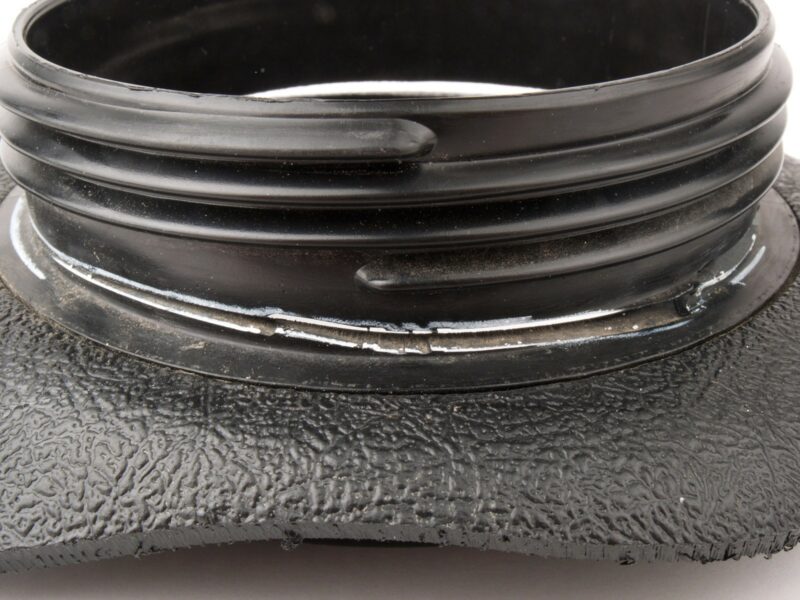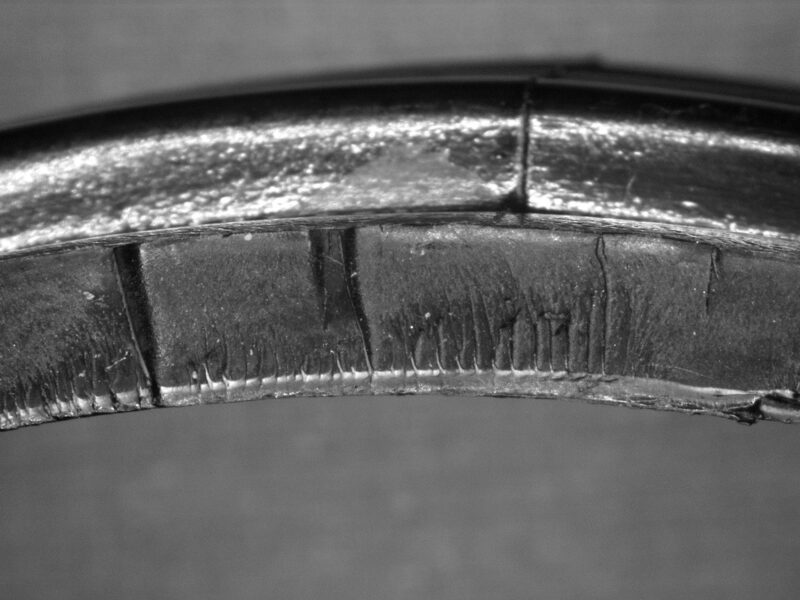This paper was originally published and presented at The Society of Plastics Engineers’ ANTEC in 2007.

Cracking was evident within the spout of the storage assembly.
Failures occurred within tank assemblies used for the storage of gasoline. The cracking was observed in a significant number of assemblies that had been in service. The cracking was found within the injection molded spout in areas immediately adjacent to the surrounding blow molded tank body. The focus of this investigation was a determination of the nature and cause of the failures. The results obtained during the evaluation of the cracked components indicated that the failures occurred through slow crack initiation via a creep rupture mechanism. This paper will review some of the testing performed to characterize the failure mode and identify the cause of the cracking, while demonstrating the analytical procedures used in the investigation.
The storage assemblies were used to hold gasoline, and catastrophic cracking occurred after an undetermined time in use. The spouts were comprised of an injection molded polyethylene spout integrated with a blow molded tank body. A separate mating cap is screwed onto the spout, such that the cap does not bottom out on the tank surface. The spouts are specified to be injection molded from Alathon® M 5370, a high density polyethylene resin from Equistar. In addition to the two failed tank sections, a spout, which had not been molded into a gasoline tank, was also evaluated for reference purposes.
The failure analysis performed on the gasoline storage assemblies included the following:
- Visual and microscopic examinations
- Scanning electron microscopy (SEM)
- Fourier transform infrared spectroscopy (FTIR)
- Differential scanning calorimetry (DSC)
- Thermogravimetric analysis (TGA)
- Specific gravity
- Melt flow rate (MFR)
It was the conclusion of the evaluation that the two submitted gasoline storage tank spouts failed via slow crack initiation through a creep rupture mechanism. Creep is the application of static, or near static, stresses to a component over an extended period of time. The exertion of stresses below the yield point of the material results in disentanglement of the polymer chains without substantial permanent deformation. The time required to produce cracking is a complex function of the applied load, temperature, and the condition of the material.

The fracture surface of the failed part showed cracking initiation along the outer diameter and no evidence of macro ductility.
The visual, microscopic, and SEM examinations of the failed parts showed multiple individual crack origins located around the outer diameter of the spout wall. The presence of multiple individual origins along the entirety of the outer diameter of the cap indicated that the stresses were principally tensile in nature with minimal bending. The cracking progressed principally through the part wall, with very little circumferential progression. The entirety of the part displayed brittle fracture features, without evidence of substantial macroductility. High magnification inspection of the crack origin locations showed a relatively smooth morphology, characteristic of slow crack growth. An increased level of microductility was observed remote to the crack origins, as indicated by the presence of stretched fibrils. This change in morphology indicated that the fracture initiated via a slow crack growth mechanism, which transitioned into a ductile, rapid overload mechanism once the cracking had extended sufficiently through the part wall. The location of the cracking was consistent across the two parts, immediately above the designed corner, just outside of the area of natural reinforcement associated with the bonding to the mating gasoline tank. It was noted that the cap does not bottom out onto the tank, and as such, the nature of the stresses responsible for the creep failure were not identified. Further information and evaluation of a complete tank/cap system would be required to more comprehensively assess the source of the stress.
Analysis of the spout samples produced consistent results across the failed and reference parts. The materials produced results characteristic of a carbon black pigmented, unfilled high density polyethylene resin. Analysis of the reference part material indicated a specific gravity of approximately 0.953, and a melt flow rate of 6.11 for the control sample. These values correlated well with those indicated on the Alathon® M 5370 Data Sheet. The results obtained on the failed part showed a specific gravity matching that of the control part. However, a slightly higher melt flow rate was obtained likely associated with the presence of gasoline absorbed into the spout material. The presence of gasoline was indicated through the TGA evaluation at a level of approximately 1.4%. It is likely that at the time of failure the gasoline was absorbed into the spout material at a considerably higher level and that subsequent evaporation occurred. Based upon previous testing, it has been demonstrated that high density polyethylene resins can absorb between 10% and 15% of their weight in gasoline at equilibrium.
The presence of gasoline within polyethylene resins results in a substantial loss of mechanical properties. The gasoline acts as a plasticizer, and as such, dramatically reduces the modulus, tensile strength, and creep resistance of the material. Thus, the presence of the gasoline is thought to have been a substantial factor in the failure. The gasoline acted as a plasticizer being absorbed into the bulk of the spout material. This is distinct from environmental stress cracking (ESC), which causes cracking localized on the chemical contact surface. The distinction in this case is subtle, yet important. The gasoline modified the bulk properties of the spout precipitating the creep rupture.
A second significant factor in the failure may be the selection of the plastic resin. The Alathon® M 5370 material has a stated density of 0.953 g/ml. This value, together with the results obtained during the DSC testing, indicated that the material is a relatively highly crystalline grade of polyethylene. In general, the higher the level of crystallinity, the more prone to creep the material will be. Thus, a polyethylene resin with a specific gravity of 0.945 would produce a spout that would be much more resistant to creep relative to the current material. Additionally, a resin with a higher average molecular weight corresponding to a lower melt flow rate would also improve the mechanical properties of the molded spout.
